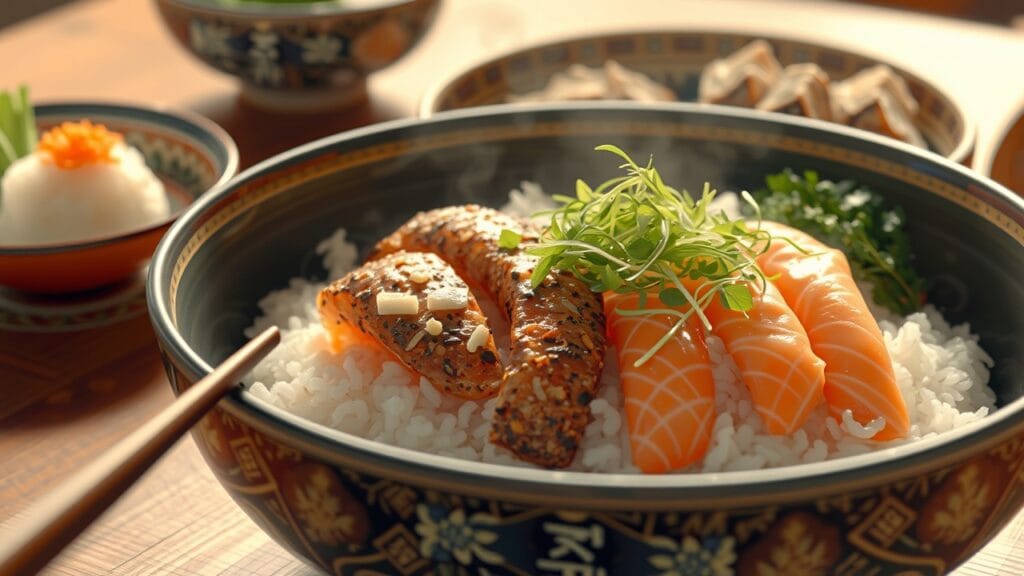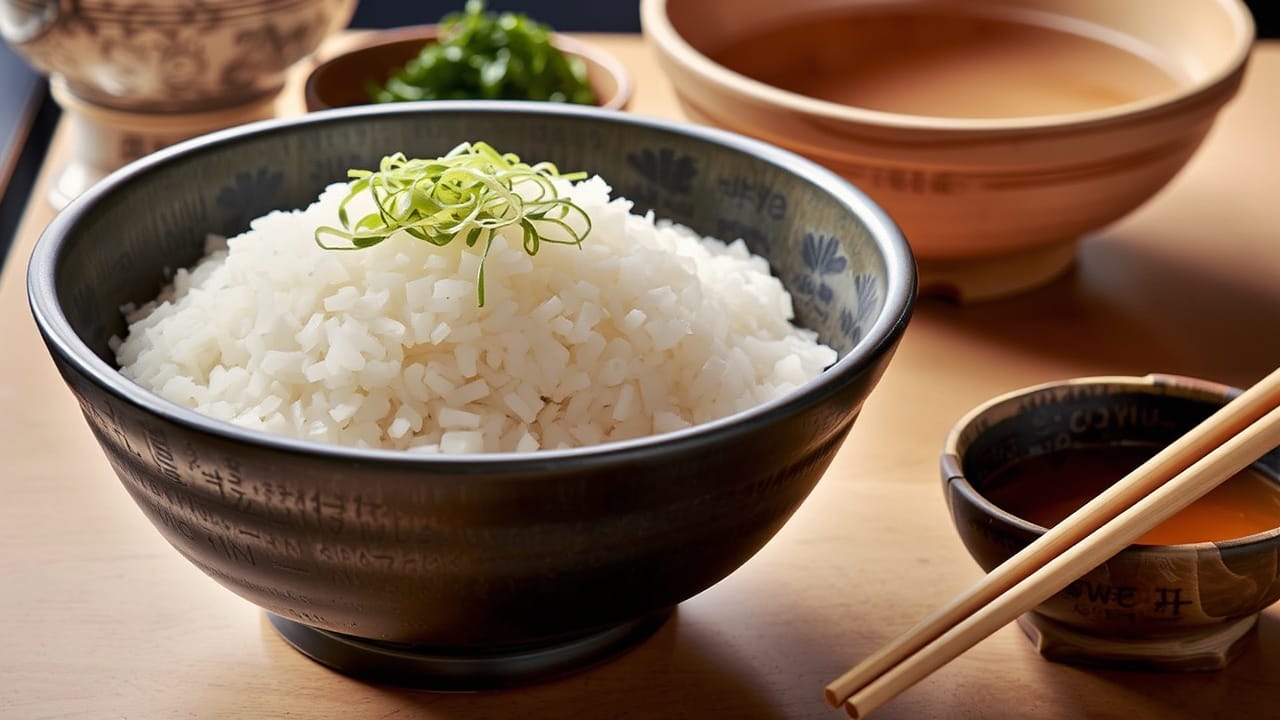Introduction: The Importance of Food in Japanese Culture
Food is not just something to fill your stomach in Japan — it’s an essential part of daily life and a rich cultural experience. In Japan, every meal is crafted with care, and the foods served are deeply tied to the nation’s history, traditions, and philosophies. Japan’s culinary culture is built on balance, simplicity, and respect for ingredients, which is why the foods served at every meal are carefully selected to provide nourishment, flavor, and a connection to the past.
If you’ve ever visited Japan or dined in a Japanese restaurant, you’ve probably noticed that certain foods make an appearance at almost every meal. Among these, two foods stand out as essential: rice and miso soup. Whether you’re having breakfast, lunch, or dinner, these two staples are present on almost every table in Japan, reflecting both tradition and the country’s approach to eating.
The Two Staple Foods Found at Every Meal in Japan
H3: Rice: The Heart of Japanese Cuisine
Rice is the foundation of Japanese meals. It’s so central to Japanese cuisine that the word for rice, “gohan”, also means “meal.” Rice isn’t just a side dish in Japan — it’s the star of the show. Japanese rice is short-grain and sticky, which makes it easy to pick up with chopsticks. It’s a simple yet satisfying food that pairs perfectly with a variety of dishes, from fish to vegetables to pickles.
But rice in Japan isn’t just any rice; it’s a cultural symbol. In Japanese tradition, rice is often seen as a sacred food, representing the harvest and the connection between people and nature. It has a spiritual significance in many Shinto rituals, and it’s often offered to the gods. When you eat rice in Japan, you’re not just filling up — you’re participating in a long-standing tradition.
Why Rice is a Staple in Every Japanese Meal
Rice is served at every meal in Japan for a few key reasons. First and foremost, it provides the bulk of the meal and serves as the main carbohydrate source. It’s filling, versatile, and easy to prepare, making it the perfect base for a meal.
Additionally, rice complements a wide variety of other Japanese dishes, such as sushi, teriyaki, and tempura. Its subtle flavor allows it to balance out stronger, more intense flavors in other dishes. Whether it’s paired with savory broths or enjoyed alongside delicate fish, rice is a harmonious addition to any Japanese meal.
Types of Rice and How They Are Served
In Japan, there are different types of rice served depending on the region and the dish. The most common type of rice is Japonica rice, known for its sticky texture. This rice is typically served as a plain side dish, but it can also be flavored with sake, salt, or sesame seeds for added variety.
In some regions, brown rice or multi-grain rice is becoming more popular due to health trends. These variations are considered more nutritious and provide a heartier, nuttier flavor compared to the standard white rice.
Rice can also be served in a variety of forms — such as in onigiri (rice balls), sushi, or donburi (rice bowls topped with meat or vegetables). But no matter how it’s prepared, rice remains a constant presence at every meal in Japan.
Miso Soup: The Essential Companion
Alongside rice, miso soup is another food that’s served at every meal in Japan. Miso soup is made from miso paste, a fermented soybean paste, which is dissolved in hot water to create a flavorful broth. The soup typically contains tofu, seaweed, and sometimes vegetables or fish, and it’s enjoyed as a warm, comforting dish that accompanies almost every meal.
Miso soup is more than just a starter; it’s an integral part of the Japanese dining experience. It’s light yet flavorful, providing a delicate balance to the richness of rice and other dishes. The warmth and umami of miso soup add depth and complexity to the meal, making it much more than just a side dish.
The Tradition of Miso Soup in Japanese Meals
Miso soup has been a part of Japanese cuisine for centuries, with roots dating back to the 8th century. It was originally a simple dish made with a miso paste and water, but over time, the soup evolved to include various ingredients based on regional preferences.
Today, miso soup is consumed at almost every meal in Japan, from breakfast to dinner. The soup is particularly popular during the colder months, providing warmth and comfort. It’s also considered an important part of a well-balanced meal, offering a rich source of umami (the fifth taste), which enhances the overall flavor of the meal.
Variations of Miso Soup Across Japan
Miso soup isn’t a one-size-fits-all dish; there are countless regional variations across Japan. The primary difference lies in the type of miso paste used, with white miso, red miso, and mixed miso being the most common. White miso is sweeter and milder, while red miso has a richer, saltier flavor. In the Kanto region (including Tokyo), you’ll often find a lighter, sweeter miso soup, while in the Kansai region (including Kyoto), a darker, saltier version is preferred.
Besides miso paste, the ingredients in the soup can vary depending on what’s available locally. For example, in coastal areas, miso soup often includes fish or shellfish, while in rural areas, it may feature seasonal vegetables or tofu.
The Role of Rice and Miso Soup in Japanese Dining Etiquette
H3: How Rice and Miso Soup Reflect Japanese Hospitality
In Japan, meals are more than just an opportunity to eat; they are a way to show hospitality, respect, and care for others. Both rice and miso soup play significant roles in this ritual. When you are invited to someone’s home or eat at a restaurant, the presence of these foods signals the warmth and generosity of the host.
Rice, as the core of the meal, is treated with reverence. It’s typically served in a small bowl, and it’s customary for diners to eat it with chopsticks, bringing the bowl close to their mouth. This is a sign of respect for the food and the effort that went into preparing it. Offering rice to others, especially during special occasions, shows generosity and goodwill.
Similarly, miso soup is served to enhance the overall dining experience. It’s meant to complement the rice, providing a contrast in texture and flavor. The warmth of miso soup, served in a ceramic bowl, invites the guest to pause, savor the moment, and appreciate the meal. It’s a simple yet profound reflection of the Japanese value of hospitality — taking the time to care for others through food.
Proper Etiquette for Eating Rice and Miso Soup in Japan
While eating rice and miso soup might seem straightforward, there are certain etiquettes that every diner should be aware of to show respect for Japanese dining customs.
- Eating Rice: When eating rice in Japan, it’s considered polite to bring the bowl of rice to your mouth rather than bending down to the bowl. This shows that you are eating with consideration and respect for the food. It’s also important to avoid leaving rice uneaten in the bowl. The Japanese value finishing your meal, as it signifies that the food has been appreciated.
- Drinking Miso Soup: When it comes to miso soup, the proper etiquette is to lift the bowl to your lips and sip the broth directly from the bowl. Avoid using a spoon; it’s seen as more respectful to drink the soup the traditional way. If the soup contains solid ingredients like tofu or seaweed, you can use chopsticks to pick them up.
These etiquettes may seem small, but they’re important in Japanese culture. Following them not only shows respect for the food but also reflects a deep appreciation for Japanese traditions.
Exploring the Nutritional Benefits of Rice and Miso Soup
H3: Rice: A Nutritional Powerhouse
Rice might seem simple, but it’s actually packed with essential nutrients. It’s an excellent source of complex carbohydrates, which provide steady energy throughout the day. Japanese rice, in particular, is rich in fiber, which helps with digestion and promotes heart health.
One of the key benefits of rice is that it’s naturally gluten-free, making it a safe choice for people with gluten intolerance or celiac disease. Rice is also low in fat, providing a healthy base for a balanced meal. However, when combined with proteins (like fish) and vegetables, rice helps create a complete, nutritious meal that meets all of the body’s dietary needs.
Miso Soup: Health Benefits Beyond Taste
it is much more than just a flavorful broth; it’s also a powerhouse of nutrients. Miso itself is made from fermented soybeans, which are rich in protein and essential amino acids. The fermentation process also creates beneficial probiotics, which can help improve gut health and boost the immune system.
In addition to the miso paste, miso soup typically includes tofu, which is a great source of plant-based protein and calcium. Seaweed, often added to miso soup, is packed with vitamins and minerals, such as iodine, iron, and calcium. These nutrients help support thyroid function, improve bone health, and boost overall energy levels.
Miso soup is also rich in antioxidants, which help fight inflammation and reduce the risk of chronic diseases. It’s low in calories, making it a great option for anyone looking for a nutritious yet light addition to their meal.
Common Problems and Solutions with These Foods
While rice and miso soup are beloved staples in Japan, preparing them perfectly can sometimes be tricky. Here are some common problems that people may face when making or eating these foods, along with practical solutions to resolve them.
Problem: Rice Getting Too Sticky or Overcooked
Rice is a delicate food to prepare. Sometimes, it can end up too sticky or overcooked, which can be a frustrating experience. This problem typically occurs when the rice is not washed thoroughly before cooking or if the water-to-rice ratio is off.
Solution: How to Perfectly Cook Japanese Rice
To avoid overly sticky or mushy rice, start by rinsing the rice thoroughly under cold water to remove excess starch. This will help the grains stay separate and maintain a light, fluffy texture. Use a rice cooker, if possible, as it provides the most consistent results. The water-to-rice ratio is typically 1:1.1 to 1:1.2 (rice: water), but it can vary slightly depending on the rice type. After cooking, let the rice rest for 10–15 minutes before serving to allow it to firm up and achieve the ideal texture.
Problem: Miso Soup Losing Its Flavor
Miso soup can sometimes taste flat or overly salty if not prepared properly. This usually happens when the miso paste isn’t mixed well with the broth or if it’s overcooked.
Solution: Tips for Enhancing the Taste of Miso Soup
To create a balanced, flavorful miso soup, make sure to dissolve the miso paste fully into the broth before heating. You can do this by mixing a little bit of hot water with the miso paste and then gradually adding it to the broth. When heating the soup, avoid boiling it, as this can cause the miso paste to lose its delicate flavors. If the soup is too salty, you can dilute it with a little water or add some dashi (Japanese stock) to balance out the flavors.
Regional Variations in How Rice and Miso Soup Are Served
The Role of Regional Ingredients in Japanese Meals
Japan’s culinary landscape is as diverse as its geography. While rice and miso soup are staples in every meal, the way they are served can vary significantly depending on the region. Each area of Japan has its own unique twist on traditional dishes, influenced by local ingredients, climate, and cultural practices.
In coastal regions, for example, miso soup may include fish, shellfish, or seaweed native to the area. The use of seafood in miso soup reflects the abundance of the sea and is an essential part of the local diet. In rural areas, however, the soup may be made with root vegetables, tofu, and other ingredients that are more common in farming communities.
Similarly, rice in Japan can differ based on the region’s agriculture. In regions like Niigata, known for its rice cultivation, you’ll find particularly high-quality rice served with meals. The rice there is often more glutinous and sticky, making it ideal for sushi or rice balls (onigiri). On the other hand, in the southern regions like Kyushu, rice can be served with a more subtle flavor, sometimes even slightly firmer or chewier, depending on the local rice varieties.
Differences in Rice and Miso Soup Across Japan
The types of miso paste used in miso soup also vary by region. For example, in the Kanto region (which includes Tokyo), people prefer white miso, which is sweeter and lighter in flavor. In contrast, in the Kansai region (including Kyoto), the locals prefer red miso, which is darker, richer, and saltier.
In some parts of Japan, miso soup may even include non-traditional ingredients, such as mochi (rice cakes) during special holidays like the New Year. This regional diversity makes each bowl of miso soup unique and reflective of the flavors and ingredients that thrive in the area.
Modern-Day Trends: How Rice and Miso Soup Are Evolving

The Impact of Globalization on Japanese Meals
In today’s world, globalization has brought new influences to traditional Japanese cuisine, and rice and miso soup are no exception. As international cuisines become more popular in Japan, there are new takes on these classic dishes. For example, fusion rice dishes such as rice cooked with herbs or spices from other cultures are becoming more common.
Miso soup is also evolving with the times. While the classic version remains a favorite, many people are now experimenting with adding different ingredients such as coconut milk, chicken, or even vegetarian substitutes for the traditional tofu and seaweed. These innovations reflect a broader trend in Japan toward blending traditional food with modern twists, catering to a diverse population that seeks convenience and variety in their meals.
Another trend that’s gained popularity is health-conscious eating. With increasing awareness about nutrition and wellness, many Japanese people are choosing brown rice over white rice and incorporating more vegetables and fermented ingredients into their miso soup for added health benefits. This shift aligns with the global rise in plant-based diets and clean eating.
Innovations in Rice and Miso Soup Preparation
Along with evolving taste preferences, new cooking methods and technologies are transforming how rice and miso soup are prepared. The introduction of high-tech rice cookers has made it easier to achieve the perfect texture, while pressure cookers and instant pots have streamlined the preparation of miso soup, making it quicker and more convenient without sacrificing flavor.
Additionally, ready-made miso paste and instant miso soup packets are becoming increasingly popular, especially for busy individuals who want a quick and nutritious meal. These modern conveniences allow people to enjoy the taste and nutritional benefits of rice and miso soup without the long cooking times.
Conclusion: The Enduring Legacy of Rice and Miso Soup in Japan
Rice and miso soup are more than just food — they are symbols of Japan’s rich cultural heritage and its dedication to balance, harmony, and simplicity in cooking. These two staple foods have stood the test of time, and they continue to be an integral part of Japanese meals, no matter the season or occasion.
From the spiritual significance of rice to the health benefits of miso soup, these foods provide nourishment for both the body and soul. Whether served at a humble family dinner or at a formal celebration, rice and miso soup remain a constant presence, reflecting the enduring values of Japanese culture.
As Japan continues to innovate and adapt its culinary traditions, rice and miso soup are evolving.yet their role as essential components of Japanese dining remains unchanged. The regional variations in how these foods are prepared and the modern-day trends that are shaping their evolution ensure that rice. and miso soup will continue to play a vital role in Japanese cuisine for generations to come.

